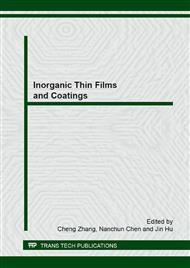[1]
R.A. Street, Thin-Film Transistors, Adv. Mater. 21 (2009) 2007–(2022)
Google Scholar
[2]
D. Knipp, R.A. Street, H. Stiebig, et al., Vertically Integrated Amorphous Silicon Color Sensor Arrays, IEEE Trans.Electron. 53 (2006) 1551-1558.
DOI: 10.1109/ted.2006.875822
Google Scholar
[3]
Y. Mai, S. Klein, R. Carius, et al., Open circuit voltage improvement of high-deposition-rate microcrystalline silicon solar cells by hot wire interface layers, Appl. Phys. Lett. 87 (2005) 1-3.
DOI: 10.1063/1.2011771
Google Scholar
[4]
S. Klein, F. Finger, R. Carius, et al., Intrinsic microcrystalline silicon prepared by hot-wire chemical vapour deposition for thin film solar cells, Thin Solid Films. 430 (2003) 202-207.
DOI: 10.1016/s0040-6090(03)00111-1
Google Scholar
[5]
H. Jia, H. Shirai, In Situ Study On the Growth of Microcrystalline Silicon Film Using the High-Density Microwave Plasma for Si Thin Film Solar Cells, Thin Solid Films. 506 (2006) 27-32.
DOI: 10.1016/j.tsf.2005.08.030
Google Scholar
[6]
Y. Sakuma, L. Haiping, H. Ueyama, et al., High-Density Microwave Plasma for High-Rate and Low-Temperature Deposition of Silicon Thin Film, Vacuum 59 (2000) 266-276.
DOI: 10.1016/s0042-207x(00)00279-7
Google Scholar
[7]
L.H. Guo, R.M. Lin, Studies on the formation of microcrystalline silicon with PECVD under low and high working pressure, Thin Solid Films. 376 (2000) 249-254.
DOI: 10.1016/s0040-6090(00)01210-4
Google Scholar
[8]
P.Roca i Cabarrocas, R.Brenot, P.Bulkin, et al., Stable microcrystalline silicon thin-film transistors produced by the layer-by-layer technique, J. Appl. Phys. 86 (1999) 7079-7082.
DOI: 10.1063/1.371795
Google Scholar
[9]
E.Amanatides, D. Mataras and D.E. Rapakoulias, Deposition rate optimization in SiH4/H2 PECVD of hydrogenated microcrystalline silicon, Thin Solid Films. 383 (2001) 15-18.
DOI: 10.1016/s0040-6090(00)01603-5
Google Scholar
[10]
R.Platz and S.Wagner, Intrinsic microcrystalline silicon by plasma-enhanced chemical vapor deposition from dichlorosilane, Appl. Phys. Lett. 73 (1998) 1236-1238.
DOI: 10.1063/1.122138
Google Scholar
[11]
J. K. Rath, R. H. Franken, A. Gordijn, and R. E. Schropp, et al., Growth mechanism of microcrystalline silicon at high pressure conditions, J. Non Cryst. Solids. 338 (2004) 56-60.
DOI: 10.1016/j.jnoncrysol.2004.02.021
Google Scholar
[12]
V. G. Golubev, V. Y. Davydov, A. V. Medvedev, and A. B. Pevtsov, et al., Raman scattering spectra and electrical conductivity of thin silicon films with a mixed amorphous-nanocrystalline phase composition: determination of the nanocrystalline volume fraction, Phys. Solid State. 39 (1997) 1197-1201.
DOI: 10.1134/1.1130042
Google Scholar


